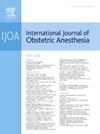将主动脉血管内球囊闭塞复苏术(REBOA)作为产后出血处理策略:叙述性综述。
IF 2.6
3区 医学
Q2 ANESTHESIOLOGY
引用次数: 0
摘要
产后出血(PPH)仍然是全球孕产妇死亡的主要原因之一,对全球健康有着重大影响。PPH 的最佳治疗方法涉及多学科方法同时执行的不同步骤,其中麻醉科医生在血流动力学控制和患者复苏方面发挥着关键作用。在这种情况下,通过内球囊阻断主动脉血流应被视为治疗或预防腹腔出血的各种机会中的一种抢救选择。有鉴于此,人们对最初用于创伤和军事医学的主动脉血管内球囊闭塞复苏术(REBOA)的作用越来越感兴趣,它已成为治疗 PPH 的一种新策略。事实上,这项技术在处理严重的 PPH 病例,尤其是在传统措施不足以解决问题的情况下,已显示出良好的前景。此外,它还可作为一种潜在的预防措施,用于高风险妊娠,如胎盘早剥。本综述旨在研究 REBOA 在 PPH 管理和预防中的有效性、安全性和潜在应用。同时,还讨论了所面临的挑战,如对熟练操作者的需求、潜在并发症、成本以及对胎儿安全的考虑。REBOA是一种很有前景的治疗PPH的工具,可有效减少失血量、保护生育能力,并有可能降低孕产妇死亡率和改善预后。然而,其实施需要慎重考虑、培训和进一步研究,以便为其在产科护理中的使用制定明确的指导方针。本文章由计算机程序翻译,如有差异,请以英文原文为准。
Resuscitative Endovascular Balloon Occlusion of the Aorta (REBOA) as a strategy for postpartum haemorrhage management: A narrative review
Postpartum hemorrhage (PPH) remains one of the leading causes of maternal mortality worldwide, with a significant impact on global health. Optimal management of PPH involves distinct steps executed simultaneously by a multidisciplinary approach, with anesthesiologists playing a key role in hemodynamic control and patient resuscitation. In this context, an aortic blood flow interruption through an internal balloon should be considered a rescue option among the various opportunities, to treat or prevent abdominal hemorrhages. Given this perspective, there is increasing interest in the role of Resuscitative Endovascular Balloon Occlusion of the Aorta (REBOA), originally used in trauma and military medicine, which has emerged as a novel strategy for managing PPH. Indeed, this technique has shown promise in managing severe cases of PPH, especially where traditional measures are insufficient. It also offers potential as a prophylactic measure in pregnancies with high risk for PPH, such as in the case of placenta accrete spectrum. This review aims to examine the efficacy, safety, and potential applications of REBOA in PPH management and prevention. At the same time, challenges such as the need for skilled operators, potential complications, costs, and the consideration of fetal safety were also discussed. REBOA presents as a promising tool against PPH, with efficacy in reducing blood loss, preserving fertility, and potentially decreasing maternal mortality and improving outcomes. However, its implementation requires careful consideration, training, and further research to establish clear guidelines for its use in obstetric care.
求助全文
通过发布文献求助,成功后即可免费获取论文全文。
去求助
来源期刊
CiteScore
4.70
自引率
7.10%
发文量
285
审稿时长
58 days
期刊介绍:
The International Journal of Obstetric Anesthesia is the only journal publishing original articles devoted exclusively to obstetric anesthesia and bringing together all three of its principal components; anesthesia care for operative delivery and the perioperative period, pain relief in labour and care of the critically ill obstetric patient.
• Original research (both clinical and laboratory), short reports and case reports will be considered.
• The journal also publishes invited review articles and debates on topical and controversial subjects in the area of obstetric anesthesia.
• Articles on related topics such as perinatal physiology and pharmacology and all subjects of importance to obstetric anaesthetists/anesthesiologists are also welcome.
The journal is peer-reviewed by international experts. Scholarship is stressed to include the focus on discovery, application of knowledge across fields, and informing the medical community. Through the peer-review process, we hope to attest to the quality of scholarships and guide the Journal to extend and transform knowledge in this important and expanding area.

 求助内容:
求助内容: 应助结果提醒方式:
应助结果提醒方式:


